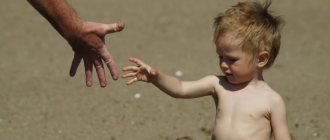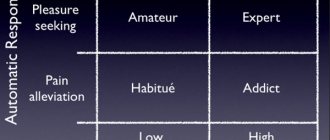Deviant behavior is any form of deviant behavior that, by social standards, may be considered unacceptable, even bordering on a crime. The deviant behavior of young people is especially depressing: it is sad to see how young boys and girls mutilate their lives, subordinating it to destructive tendencies and momentary whims. You need to know how to deal with this problem and prevent the development of serious consequences. The problem is that young people fall under the influence of their peers and do not always understand why and for what they need to change.
Causes
For the development of obvious deviations, compelling reasons are required. Nothing happens in life just like that. Certain factors contribute to the accumulation of negative impressions and form attitudes that prevent the creation of a positive picture of the world. Let's take a closer look at the reasons for what is happening. Perhaps this will help someone decide on next steps.
Dysfunctional family
This is the most common reason why deviant behavior occurs. We all come from childhood. It is impossible to discard this experience or imagine that it did not exist. A dysfunctional family influences the formation of personality more than the social environment. There is a substitution of some concepts, a denial of general family values. In a family where there is no respect, there is no acceptance. A child may grow up withdrawn and unfriendly, afraid to express his point of view. This does not contribute to the accumulation of positive energy or the formation of a positive outlook on the world. In most cases, the child repeats the parents' experience. Patterns of behavior, attitudes, and ways of reacting in various situations will be unwittingly copied. Deviant behavior of an individual always leads to destruction. An individual cannot endlessly accumulate anxiety and irritation within himself. Ultimately, this will result in a continuous stream of aggression and condemnation.
Bullying in a team
Another common reason that contributes to the accumulation of negative emotions. Bullying, no matter how it is expressed, always ends in devastation of the individual. A person ceases to feel himself from the inside and does not know what to do. The sense of reality of what is happening is lost, the safety of the outside world is called into question. Bullying in a team is a powerful argument that causes pain and suffering. In some cases, specialist help may be needed. After all, if a person is constantly being oppressed, then he cannot then build full-fledged relationships or act according to the dictates of his heart. It seems that a reservation is being formed in the soul, preventing the formation of emotional attachment. Negative deviant behavior is the result of an inability to make the right choice and decide on further steps.
Peer influence
The desire to assert oneself sometimes leads to uncontrollable consequences. There are many examples of deviant behavior among the younger generation: peers persistently demand that the emerging personality adhere to certain rules and guidelines. Peer influence has a huge impact on an individual. There is nothing sadder than seeing that a teenager has not taken the best path. The destructive influence of peers can be quite serious.
Low self-esteem
This is a serious problem that can devalue any endeavor. Low self-esteem does not allow one to claim a high position in society, makes people be content with little, and does not lead to development. Often this becomes the reason that a person ceases to value himself. As a result, you may get the feeling that there is no justice in the world, so you can do whatever you want, do any crazy things. Adolescents and children develop a feeling of incomprehensibility, and there is a gradual accumulation of disappointment in the outside world. In this regard, they try to attract the attention of parents, teachers, and any people around them. Deviant behavior works as a form of protest. The individual is not aware of his own motives because he acts based on negative impressions.
Various fears
Phobias prevent us from moving forward in life. They dominate circumstances and contribute to the formation of a distorted picture of the world. A person who is afraid cannot make meaningful decisions. He constantly doubts himself, spins alarming scenarios in his head that he cannot cope with. That is why working with children with deviant behavior always begins with working through fears. It is necessary to look at the situation from the inside to understand how it can be dealt with as a result. Otherwise, even the most effective methods may turn out to be ineffective.
Deviant behavior of youth
⇐ PreviousPage 13 of 22Next ⇒Basic concepts. Deviant, or deviant (from the Latin deviatie - deviation), behavior is always associated with the inconsistency of human actions, actions, and activities with the norms, rules of behavior, stereotypes, expectations, attitudes, and values common in society or its groups. At the same time, some sociologists take expectations of appropriate behavior as a starting point (“norm”), while others take standards and patterns of behavior. Some believe that not only actions, but also ideas can be deviant. Deviant behavior is often associated with society's response to it and is then defined as “a deviation from a group norm that results in isolation, treatment, imprisonment, or other punishment for the offender.”1
The words “deviant behavior” refer to both specific actions of a particular person (“Ivanov committed a theft”, “Petrov uses drugs”), and a relatively massive stable social phenomenon: crime, drug addiction, prostitution, etc.
So, by deviant behavior we mean:
1)
an act or
actions of a person that do not correspond to officially established or actually established norms and expectations in a given society (social group);
2) a social phenomenon,
expressed in relatively massive and sustainable forms of human activity that do not correspond to officially established or actually established norms and expectations in a given society.
In the first meaning, deviant behavior is a subject of psychology, pedagogy, and psychiatry. The second is the subject of sociology, social psychology.
Since behavior that does not correspond to social norms and expectations is considered deviant, and norms and expectations differ not only in different societies and at different times, but also among different groups in the same society at the same time (legal norms and “thieves’ law”, adult norms and youth norms, etc.), to the extent that the concept of “generally accepted norm” is relative, and, therefore, deviant behavior is also relative (relative).2
The starting point for understanding deviations is the concept of norm.
In the theory of organization, the most general idea has developed of it as the limit, the measure of what is permissible for the preservation and development of the system. For physical and biological systems, these are the permissible limits of structural and functional changes that ensure the safety of the object and do not create obstacles to its development. This is a natural (adaptive) norm, reflecting the objective patterns of preservation and change of the system (for example, for a person, a normal body temperature is 4-36.6°, blood pressure is 120/70 mm Hg).
Social norm
determines the historically established limit, measure, interval of acceptable (permissible or obligatory) behavior of people, social groups, organizations in a particular society. In contrast to the natural norms of physical biological systems, social norms develop as a result of the reflection in the consciousness and actions of people of the objective laws of the functioning of society. A social norm can either correspond to these patterns (and then it is “natural”), or reflect them inadequately, being a product of a distorted (religious, politicized, mythologized) reflection of objective patterns. And then the norm itself turns out to be abnormal (unnatural), while deviations from it are normal.
Therefore, in particular, social deviations
may have a double meaning for society. Some of them—positive—serve as a means of progressive development of the system, increasing the level of its organization, eliminating standards of behavior. This is social creativity (scientific, technical, artistic, etc.). Others—negative ones—disturb the existence or development of the system and disorganize it. This is the so-called social pathology (crime, drunkenness, drug addiction, prostitution, etc.). True, “pathology” is often adaptive and functional, otherwise its manifestations would be eliminated in the process of evolutionary selection. Creativity is always a violation of norms, rules, standards, otherwise it would not be creativity.”
The boundaries between positive and negative deviant behavior are fluid in the time and space of societies. In general, organization and disorganization, chaos and order, “norms” and “anomaly” (“pathology”) are complementary only in the aggregate; they appear together, inextricably and cannot exist without each other. That is why ideas about the possibility of “destroying,” “overcoming,” “eradicating” this or that negative social phenomenon using prohibitive, repressive or other measures are illusory and utopian.
The above does not mean a call for the abandonment of all norms and responsibility for their violations, but only for a very flexible, soft, unhurried and thoughtful multi-alternative reaction of society and the state to social deviations with the constant fulfillment of the requirement “Do no harm!”
Research shows that attitudes towards immoral acts and crimes often have the character of a “sliding morality”. For many young people, theft, racketeering, speculation, illegal currency transactions, and prostitution are not considered crimes. In recent years, a distinctive feature of juvenile crime has become a selfish orientation.4
The criminal consequences of demonstrating scenes of cruelty and violence through the media, as sociological studies show, are closely related to the psychological tendency of children, adolescents and young people to imitate their favorite idols. Regular contemplation of superheroes, who are not afraid of any fights or carnage, often forms the conviction that only with the help of strength can one achieve success in life. Moreover, girls are not much behind boys in manifestations of cruelty. Nowadays, children and adolescents often face a choice: who to become—a victim or a criminal. Many choose the second path. Or them .
A typical “set” of juvenile crimes is theft, car theft, robberies, assaults, and hooliganism. The worst thing is that crimes are committed with unprecedented cruelty.
A representative survey of the population of St. Petersburg, conducted in December 1995 (1052 respondents were interviewed), showed that 26% of respondents became victims of various crimes in the past year. Among crimes, the proportion of women is growing (intentional murder, serious bodily injury, robbery, theft, hooliganism); For minors and young people, crimes related to violence (robbery, hooliganism) are typical.
In recent years, the latency of intentional murders has increased significantly, in particular, due to the rapid increase in the number of “missing people”, a significant part of whom have been killed.
In 1993, for the first time in St. Petersburg, the mortality rate from homicide (27%) exceeded the mortality rate from suicide (23.9%). This ratio is typical only for some Latin American countries. This trend continued in 1994.5
The results of a questionnaire survey of 456 juvenile offenders, conducted in December 1995 in a pre-trial detention center (153 people) and in the Krlpinsky educational and labor colony (303 people), are interesting. The respondents answered the survey questions very conscientiously and diligently. The study showed that 53.6% (55.0) were convicted (prosecuted) for the first time. The defendants' answers are given in brackets.
43.8% (27.5%) had a deferred sentence. Unfortunately, the court's trust did not stop many young men from committing repeated crimes. Which ones?
From the answers it follows that in first place: thefts—61.2% (54.2%), in second: assault and robbery—36.7% (28.1%), in third: hooliganism—11.2% ( 8.5%), in fourth place: rape—5.4% (3.3%). Other crimes were also named - 14.3% (14.4%). The sum of the answers exceeds 100 percent, because Some respondents committed more than one crime.
The questionnaire asked: “What prompted you to commit a crime?” A persistent stereotype has emerged, which comes from a kind attitude towards people and is introduced into our consciousness by the best works of world literature: a person is driven to commit crimes by poverty, constant malnutrition, and a feeling of hunger. Partly. Here are the answers from our respondents. Experienced a feeling of hunger in freedom: always—0.7% (2.0%), often—4.6% (3.9%), sometimes—44.4% (36.6%), never—48.4 % (56.9%). This result can be explained by the fact that most of these young people were dependent on their families. And although 37 million Russians now live below the poverty line, parents (the majority) are trying their best to feed, clothe and put on shoes for their children. And the child takes his first steps into adulthood. They have their own ideas about the world.
But what prompted respondents to commit crimes today? More than half—56.6% (55.6%) answered simply their own stupidity. Second reason: bad comrades—17.8%. The following reasons were also named: coincidence of circumstances - 15.1% (24.2%), committing a crime consciously - 14.6% (9.2%), other reasons - 11% (7.8%).
Let us note once again that “your own stupidity” comes first. But do only fools commit crimes? Or maybe “your own stupidity” hides the lack of spirituality of existence, a protracted childhood, moral, spiritual and social underdevelopment? Such an individual lives one day at a time, caught up in the flow of life, carried along like a piece of wood. Until the grief hits, he won’t think about it.
Bad comrades were named in second place among the reasons that pushed people to commit crimes. This is again an attempt to abdicate personal responsibility.
Several years ago, at the request of the editors of the Nadezhda newspaper, we analyzed the essays “Mom and Me in this big and complex world.” Their authors were convicts from the Kolpino colony. Many wrote in their essays: I was given a reprieve of execution. I left the courtroom with my friends waiting for me. “Washed.” And he ended up behind bars again.”
There is such a thing as “crowd psychology”. “What am I?” the young man says in this case. “I’m like everyone else.” In a crowd, in a criminal group, a person is usually impersonal and alone, although at first it seems to him that they understand him. However, most often he blindly obeys the commands of the leader of the “pack”.
Numerous sociological studies have shown that the most susceptible to various types of deviations was the age of 14-15 years, when the worldview has not yet developed and adolescents are more susceptible to the influence of others and especially their peers.6 Such “bad habits” as are well known in pedagogy, such as smoking and foul language , the use of alcoholic beverages and other intoxicants are considered among adolescents as a behavioral standard.7
Specifics of deviant behavior of young people. Deviant behavior of adolescents (14-17 years old) and young people (18-29 years old) has common causes for all deviant manifestations. First of all, this is a contradiction between relatively evenly distributed and growing needs and significantly different possibilities for satisfying them, or, in R. Merton’s terminology, a discrepancy between social values, aspirations and socially organized means of satisfying them.8
A person's capabilities are determined mainly by his social status, the place occupied in the social structure. In other words, the source of deviant behavior is social inequality, inequality of opportunities available to people belonging to different social groups (strata).
If this is so, then we should consider how, specifically for adolescents and young people, social inequality manifests itself, the contradiction between needs (values, aspirations) and the possibilities of satisfying them.
Firstly, in all societies the concepts of “elder” and “younger” mean not only age differences, but also status ones. “The concept of “seniority” has not only a descriptive, but also a value, social and status meaning, denoting some inequality or at least an asymmetry of rights and responsibilities. In all languages, the concept “younger” indicates not only age, but also a dependent, subordinate status.”9 So age differences turn into social inequality. And in Russian society, children, adolescents, and young people suffer not only from misunderstanding or repressive measures of “upbringing,” but also from inequality of position, inequality of chances compared to adults to receive appropriate housing, work, and remuneration for it; Today young people are the first candidates for the unemployed.
Secondly, the contradictions between the constantly growing needs of people and the relatively unequal opportunities to satisfy them become especially acute in relation to young people due to the contradiction between the increased energy potential of young people, the rapid development of their physical, intellectual, emotional forces, the desire to assert themselves in the adult world and insufficient social maturity, insufficient professional and life experience, and, consequently, a relatively low (undefined, marginal) social status.
Thirdly, with regard to young people, there is an acute problem of “channeling” energy and social activity in a socially approved, acceptable direction, because young people especially need social recognition and self-affirmation, and the unsatisfied need for self-affirmation leads to attempts to realize themselves not only in creativity, but and in negative actions, crimes (“Herostratus complex”) or leads to “withdrawal” (alcohol, drugs, suicide)—as a form of passive protest.
In addition to the general causes of deviant behavior and their actions among young people, we can also name some factors that determine the greater likelihood of the implementation of certain forms of deviations. Thus, an unsatisfied need for self-affirmation relatively more often leads to violent crimes. There are factors that increase young people’s craving for alcohol and explain the “choice” of this particular form of deviant behavior. If alcohol generally facilitates communication between people, then for adolescents and young people this property becomes especially significant: due to lack of social experience, timidity, and inexperience in communication between the sexes, some try to gain greater self-confidence with the help of alcohol, overcome embarrassment, feelings ( justified or unfounded) inferiority, etc. Through alcohol abuse, adolescents demonstrate their “adulthood”, belonging to the world of adults (the so-called “status” alcohol consumption).
If for some teenagers and young people crime is sometimes a means of active self-affirmation, then for others it is preferable to “withdraw” from an alien, incomprehensible world into alcohol, drugs, or voluntary death. Consumption of alcohol and drugs, suicidal behavior are forms of withdrawal, withdrawal as a result of rejection (conscious or unconscious) of social reality and the inability (unwillingness) to adapt to it in ways approved by society.
According to the concept of “double failure” by the American sociologist R. Merton, retreatant forms of behavior arise in the presence of two circumstances: 1) prolonged failure to achieve goals shared by society through legal means and 2) inability to resort to illegal (criminal) methods of achieving these goals. “Double failure” leads both to individual retreatism and to the formation of retreatist subcultures.
In general, communities with a predominance of norms, values, and patterns of behavior that differ from those dominant in society form value-normative subcultures (criminal, retreat, teenage, bohemian, etc.)
A subculture is formed as a result of the integration of people whose activities and lifestyles oppose (do not correspond to) the dominant ones in society, and are therefore rejected by them.
Subcultural communities are the more united and different from the dominant culture, the more vigorously and harshly they reject it. Therefore, for example, a group of drug addicts is more integrated than a group of alcoholics, but less than a community of criminals or convicts.
Adolescents and young people are more often integrated into subcultural groups than adults. This is explained by the natural desire to unite in conditions of “abandonment” and unfriendliness of the adult world, and the search for friendly and sexual contacts and affections that are so significant for young people, and understanding of peers when adults do not understand, etc. P.
The formation of retreat subcultures (communities of drunkards and alcoholics, drug addicts, hippies) is led by: 1) personal disorder and dissatisfaction (as a result of the contradictions of socio-economic development, social conditions of life); 2) inability or rejection of active forms of self-affirmation, overcoming conflict situations, frustration (“double failure”); 3) the need for communication, in the reference group (“it is not alcohol that is chosen, but company”); 4) integration of informal groups as a consequence of the pressure of social control.
Many teenage groups are socially neutral or recognized by society. Others are clearly antisocial in nature.10
Approximate typology of associations with deviant behavior and antisocial consciousness
next:
1. A random group—for example, those who start fights in discos, stadiums and other places, but have their own unwritten group norms and values. Moreover, joining a random group is perceived as a signal of liberation from social control, as an opportunity to “let go of the brakes.” In addition, it is well known that the actions performed by an individual in a crowd seem to him anonymous, as if not personal actions.
2. Retreat group (retreat in sociology and psychology is understood as the desire to escape from reality, from life’s difficulties. The extreme option of escaping reality is suicide). The usual activities of retreat groups are aimless pastime, dubious entertainment, substance abuse and drug addiction.
3. Aggressive group—based on the most primitive ideas about the hierarchy of values and a minimum of culture. It has come down from ancient times to the present day almost unchanged. The characteristic features of an aggressive group are a rigid hierarchical structure, strong group pressure on its members, serious sanctions for violating group norms, the psychological basis of which is a sharp opposition: “us-them”.
For criminogenic groups, suggestibility and conformism are especially characteristic features. Members of “packs” usually come from conflicting families. And from here comes the primitive level of thinking.
In a group, a teenager goes through a kind of school of false collectivism, risk, romance, meanness and cruelty. Here they support him financially and convince him that he “can do anything.” Such “packs” are rightly called youth gangs.
For quite a long time in our country, mass fights among teenagers, their cruelty and vandalism were naively considered “boyish” pranks, mistaken for a kind of youthful fun for which Russia had long been “famous”. As a result, the groups, rigidly organized by criminals, were called groups of “difficult teenagers” who “will fight today and make peace tomorrow.” But today, often these fights are not random, but appointed, and the leaders themselves do not participate in them.
A teenager in his complex and cruel world is much less protected than in his childhood. Therefore, often not accepting the style of relations in the group, he is forced to be in it. Otherwise he is an outcast. For for a teenager, the most important thing is communication, the feeling of “we,” awareness of one’s “I.”
Herself. The teenage environment is very aggressive. Relationships are often built on dishonesty, humiliation of the weak, and even outright cruelty. Children who are unwanted by family and school become social outcasts, terrorize others, rob and rape.
Sociologists, criminologists and psychologists have typologized gang members and identified the following:
1. "Outsider"-
a person who has found himself in a dead end in life, a loser who has not found recognition in a formal group or organization, and has no opportunities for self-realization.
2. "Marginal"—
a lonely person who has lost individual social connections, constantly experiences social and psychological discomfort and often tries to assert himself through immoral behavior.
3. "Conformist"-
a person who is easily influenced by authorities, adapts well to a new social microenvironment, and quickly and effortlessly assimilates group values and norms.
4. "Opportunist"—
a person who accepts group values and norms only externally in order to achieve recognition and increase his status in the group, and due to this, prestige in society.
5. "Fan"—
a person devoted to the values and symbols of the group, strictly observing the norms accepted here and rejecting everything that goes against its values.
6. "Fighter"-
a person for whom the process of fighting for an idea means more than the idea itself, always ready for active action to protect group interests, its autonomy and values.
7. "Leader"-
a person who sees his recognition in leading people, claims to be a leader in a group, shows the initiative of an organizer and often actually has quite good abilities for this.
8. "Companion"-
a person who accidentally joined a group, has not fully defined his value orientations, and is guided more by solidarity than by group goals and norms.
9. "Simulator"-
a person for whom the external attributes and symbols of the association, which constitute a source of pride for him, are of paramount importance, while he does not bother himself too much with an analysis of group values and goals.
10. "Bored"-
a person whose motive for joining a group is the hope of organizing his leisure time more meaningfully and finding an environment for communication.
In crime, it is wretchedly primitive: weak - perish, strong - survive. “Force” often means group reprisals against individuals who somehow did not satisfy their demands.
In teenage groups, such qualities as sensitivity, attentiveness, responsiveness and kindness are very often ridiculed, since universal human qualities are denied. Hence the cruelty, sometimes reaching the point of sadism, swagger, vile insults addressed to “clean boys and girls” who “sit at home, read books and study well.”
This is how unquestioning submission to the “leaders” and “chief leaders” of street companies is established, the desire to “be followed” is imposed.11 The lack of warm emotional contacts with parents in the family can lead to irreversible disorders in the child’s psyche, and subsequently aggressive behavior.12 As a famous doctor noted and teacher Dr. B. Spock, “criminals grow out of children who have suffered not from a lack of punishment, but from a lack of love.”13 Numerous observations of children and experiments with animals lead researchers to the conclusion that punishment not only does not eliminate aggressiveness, but encourages and strengthens it. Criminologists and law enforcement officials are well aware that the vast majority of people who committed violent crimes were humiliated, punished, and suffered harsh (or even cruel) treatment from adults in childhood.
Battered children, as a rule, do not want to return to their family. Crisis services cannot provide them with shelter. The guys are hiding in the apartments of friends, in shelters for street children, or wandering around. Very often they are selected by people from criminal backgrounds.14
How to deal with sadistic parents? Of course, they can be deprived of their rights to the child. But this is a long and painful process. Our laws do not provide for a quick response to child abuse. The Criminal Code has Art. 113, which punishes torture, but in practice it is almost never used. And will a child go to court with a complaint against his own parents, because he can be called Pavlik Morozov?!
They said that 79% of the colonists and 60% of those under investigation were beaten in childhood. To the question: “If they beat you, then who?” answered as follows: father—62.4 (23.5%), mother—40.4% (24.8%), brother—10.3% (3.3%), sister—6.4% (2. 6%), other relatives—6.8% (2.6%), peers—38.0% (17.6%), educators—7.7% (4.6%).
To the question: “Is a person close to you in prison?” 55% of the colonists and 47.7% of those under investigation answered affirmatively. These are: mother—10.7% (4.6%), father—7.7% (1.3%), stepfather (stepmother)—4.8% (1.3%), brother (sister)—25 .0% (6.5%), other relatives—8.3% (5.2%), friend (girlfriend)—67.3% (35.3%).
According to respondents, they first tried alcohol at the age of: under 10 years old—27.3% (17.7%), 11-13 years old—41% (36.6%), 14-16 years old—24.7% (34 .0%). Only 1.6% (1.3%) have not tried alcohol. To the question: “Who suggested it to you?” respondents answered as follows: friends - 54.3% (53.0%), relatives - 3.6% (9.8%), himself - 30.3% (27.5%), others - 4.3% ( 4.6%).
To the question: “Do you allow a crime to be committed after serving your sentence?” the following answers were given: “La” - 8.2% (9.2%); “Rather, yes”—8.6% (3.3%); “I don’t know how it will work out”—32.9% (32.7%); “No”—45.1% (51.6%). I would like to believe that these are not just words.
After serving their sentence, they plan to: live by their labor, work in their profession—47.7% (34.6%), organize their own business—18.4% (18.3%), continue their studies—21.7% (35. 9%), work in security—2.0% (2.6%). Do other things—18.4% (13.7%). Which ones? The future will show.
77.3% (80.4%) plan to live with their parents. They said that they had no parents—5.9% (5.2%). Of the total number of respondents, 9.5% of colonists and 4.6% of those under investigation were vagrants.
We also asked respondents: “What did you learn while in prison?” The answers are as follows: value family—75.3% (60.8%), learned a profession—31.3% (1.3%), cruelty—25.0% (16.3%), the ability to forgive—30.3 % (13.1%).
10.2% of colonists and 7.2% of those under investigation consider themselves cruel people.
Psychologists have found that if there is little love in the relationship between parents and children, the child often grows up aggressive. Moreover, aggression and hostility are directed not only at the parents themselves, but also against the social environment, school, and comrades.
The head of the department of the Prosecutor General's Office of the Russian Federation, G.F. Polozov, cited the following figures: “Over the past two years, over 40 thousand minors have suffered from crime. They, according to the results of sample studies, make up 36% of victims of sexual crimes. But official statistics do not reflect the picture. The number of juvenile vagrants has increased sharply. If throughout the RSFSR there were 50 thousand little fugitives held in reception centers throughout the RSFSR, now there are of them .”15
In families occupied with the problems of survival, children are left to their own devices.
The attitude towards “little brothers” is one of the most important indicators of a real, although often hidden, attitude towards people. There are research results indicating this. For example, of the 135 people prosecuted for serious violent crimes, 118, or 87.7%, had tortured animals as children.16 At this stage (as well as at the subsequent stage), specialization by sex is extremely important. Its defects can lead an adult to various kinds of deviations and deviant behavior.
Notes
l Smelzer N.-J. Sociology // Sociological research. 1992. No. 1. P. 132.
2See: Akers R. Deviant Behavior: A Social Learning Approach. Belmont, 1985; Higgins P., Butler R. Understanding Deviance. Me Graw—Hill Book Company, 1982; Palmer S., Humphery Y. Deviant Behavior: Patterns, Source and Control. New York, 1990; GilinskyYa., Afanasyev V. Sociology of deviant (deviant) behavior: Textbook. St. Petersburg, 1993.
3 See: Gryaznov B.S. Logic, rationality, creativity. M., 1982. S. 241-251; GilinskyYa. I. Creativity: norm or deviation? // Sociological research. 1990. No. 2. P.41-49; Ben-YehudaN. Positive and Negative Deviance: More Fuel for a Controversy // Deviant Behaviour. 1990. Vol.11. No. 3.
4 See: Gilinsky Ya. Crime in St. Petersburg // St. Petersburg in the early 90s: crazy, cold, cruel. 2nd ed. / Ed. K. Astafieva, M. Dmitrieva. St. Petersburg, 1994. pp. 84-88.
5 Afanasyev V., GilinskyYa. Deviant behavior and social control in the context of the crisis of Russian society. St. Petersburg, 1985. pp. 25-43.
6 Criminology: Textbook/Ed. V.V. Orekhova. St. Petersburg, 1992.
7 Zakharchuk V. A. Norms and deviations in the teenage environment. Auto-ref. Ph.D. dis. Tyumen, 1994. pp. 15-79.
8 Merton R. Social theory and social structure // Sociological studies. 1992. No. 2, 3, 4.
9 Kon I. S. Child and society. M., 1988. P. 85.
10 Claward R., Oulin L. Differentiation of subculture // Sociology of crime. M., 1966. P.334-354; Cohen A. Contents of the delinquent subculture // Ibid. pp. 314 -321; I b l o ne k i i L. A gang of de-linquents as an intermediate group // Ibid. pp. 355-366; Criminologists about informal youth associations / Rep. ed. I.I.Karpets. M., 1990.
11 For more details, see: Lisovsky A.V., Lisovsky V.T. In search of the ideal. Dialogue of generations. Murmansk, 1994. pp. 149-155.
12 Kholyst B. Criminology: main problems. M., 1980. S. 110—111.
13 Literary newspaper. 1968. No. 10. P. 11.
14 Zasorin Oleg. Who will protect a child from violence? // Change. 1994. December 2
15 Komsomolskaya Pravda. 1995. July 12.
16 Ogonek. 1988. No. 21. P. 16.
⇐ Previous13Next ⇒
Forms
There are several types of deviant behavior. All of them should be taken into account so as not to accidentally find yourself in a difficult situation. Forms of deviant behavior deserve close attention because they affect the behavior of an individual and shape his future. Let's look at the most common options. Many people know about them, but do not correlate them specifically with manifestations of deviation.
- Addiction. Because it can be considered a disease and not just a bad habit, it destroys all individuality. A drug addict cannot be a good family man, nor a worthy brother, son or husband. This contradicts the concept of family and its eternal values. Even if at the very beginning of his “hobby” a person joked cheerfully and stated that he could quit at any time, as a rule, this does not happen.
- Alcohol consumption. This form of deviant behavior, unfortunately, is familiar to many firsthand. Alcohol use harms not only individuals, but also society as a whole. As a result, families collapse, and there is a feeling of precariousness and instability in the outside world. In a family where one or both parents drink, the child cannot grow up to be a full-fledged person. A certain psychological trauma will be received, mistrust, rejection and hostility will form. Some young people are so traumatized that they are then afraid to get married, although they begin an independent life early.
- Crime. Any form of crime contributes to the corruption of the soul. A person stops appreciating those around him and treats people as things that do not deserve attention. All highly spiritual values are trampled, forgotten, rejected. Manifestations of crime can be different - theft, premeditated murder, theft. One thing is inevitable - society condemns such acts.
- Prostitution. It is no coincidence that selling one's body is considered a crime against morality. Human morality comes into question.
- Suicide. Suicidal tendencies cannot be considered natural for a person. It is normal when a person, on the contrary, tries with all his might to save his life. It is not normal to have a desire to say goodbye to life even in the face of serious shocks. Love for life is what defines us and makes us take active steps.
Categories of deviant behavior of adolescents
- Antisocial. Misdemeanors are based on violations of legal norms, public order, prohibited by law. For adolescence, this is theft, vandalism, hooligan behavior, drug trafficking, violence.
- Amoral behavior. Actions that are associated with a violation of moral standards, they threaten normal interpersonal relationships. Teenagers are characterized by vagrancy, drug use, aggression, alcoholism, and sexual disorders.
- Self-destructive (autodestructive) behavior. Actions that involve harming oneself. Adolescents are characterized by computer, chemical and food addiction, as well as suicidal tendencies.
Separately, the tendency to suicide is considered, which can be a consequence of both an asocial lifestyle and destruction. A teenager may begin to think about suicide for many reasons:
- drug addiction,
- severely low self-esteem,
- constant conflicts, quarrels in the family,
- alcoholism,
- clouding of mind,
- refusal of intimacy.
Fighting methods
A very pressing question that many people ask due to the inability to quickly cope with the situation. Working with deviant behavior involves revising previous ways of interaction. It will take a lot of effort to avoid uncontrollable consequences. Here are some reliable methods.
- Talking through the situation. This must be done in a timely manner in order to prevent the situation from getting completely out of control. It is necessary to talk about your feelings and teach your child this. Then it will be easier to make a decision and push you to the right step. An open discussion of the current situation will allow us to find common ground and reach the expected level of understanding.
- Control . Correction of undesirable behavior is impossible without vigilant monitoring. If there is a person nearby who, by definition, cannot be trusted, then it is necessary to monitor his actions and not allow anything to interfere with mutual understanding. Control can be complete or partial. Sometimes it is better to show attention unobtrusively, so as not to irritate your opponent.
- Help from a specialist. In some cases, consultation with a professional psychologist may be required. There are problems that are difficult to deal with on your own. When we quickly begin to look for a way out of a situation, it’s nice if there is a competent specialist nearby who can give timely advice. There is nothing wrong with asking for help when you need it.
- Useful things. A person who is prone to deviant behavior must be assigned activities that require physical labor. This could be cleaning the house, taking out the garbage, ironing clothes, or doing laundry. It would seem, why is this necessary? How can such actions affect the improvement of the situation? It turns out that this is possible. The fact is that physical labor sometimes takes a lot of effort and requires great concentration. By expending energy, a person calms down. There is no strength left to commit terrible and uncontrollable acts.
- New hobbies. If a person has a business that inspires him and really likes, it will be easier to come to an agreement with him. There is no shame in offering something interesting and sharing your accumulated experience. It is especially valuable when parents find common hobbies with their child. You can play football, draw, sculpt, write poetry, read literature, or any other type of creativity. The main thing is that positive emotions are present, a feeling of some community and unity arises.
- Sports activities. Without a doubt, movement helps improve physical and mental health. There will be more energy that can be directed in a peaceful direction. Exercising releases positive energy and contributes to the creation of useful fatigue. It doesn’t matter what sport you choose. The main thing is that it brings joy and helps fight negative habits.
Classification of types of deviant behavior
The most typical manifestations of deviant behavior are:
- Alcoholism and drug addiction.
- Criminal activity.
Alcoholism and drug addiction
Statistics prove that most minors try alcohol, cigarettes and drugs during adolescence. There are many reasons for this. This includes curiosity, the desire to prove “maturity,” and the fear of ridicule from peers.
A common reason is lack of information. Children do not realize the consequences of such actions, and sincerely believe that 1-2 times will not cause harm and they are not in danger of becoming addicted.
The presence of dependent relatives plays a special role. If alcohol and cigarettes are freely available in the family, and the child constantly sees examples of their use, sooner or later he will copy the behavior of adults.
Criminal activity
The false sense of freedom that alcohol gives is often the reason why teenagers commit crimes. A crime may have a selfish motive, such as theft.
Often there are completely senseless acts of vandalism or hooliganism. Their cause may be alcohol or drug intoxication, as well as the desire to vent accumulated anger in adolescents with a low level of sociocultural development.
Prevention
To prevent the formation of deviant behavior, it is necessary to build trusting relationships with children. This requires effort, sometimes enormous, which, it seems, does not always pay off. But in fact, time spent together is priceless. The best prevention is understanding and acceptance. We must abandon condemnation, reproaches, and uncontrolled aggression. Then it will be possible to replenish your internal resource and fill it with positive endeavors. In order for relationships with children to develop successfully, you must strive to give them more joy.
Thus, deviant behavior is a serious problem that requires close attention from a person. It will take a lot of effort to free yourself from negative influences. In most cases, this is successful, since the specific result depends on the aspirations of the individual. If you cannot cope with the problem on your own, you can seek advice from the community of psychologists and rehabilitation specialists Irakli Pozharisky. Working with a professional will help you find the right approach and determine next steps.
Adolescent vulnerability
The transition period is difficult for both parents and teenagers. No longer a child, but not yet an adult - a change in social role is not always painless. It comes as a shock to parents to discover that the opinion of some Vasya’s peer becomes much more significant for the child than parental authority.
Features of adolescence:
- ambition;
- maximalism;
- demonstrative courage;
- inconsistency;
- thirst for active activity;
- receptivity to information;
- critical thinking.
These age-related characteristics are quite sufficient for the development of internal and external conflicts.
And if during this unstable period a negative external influence is added, which parents and teachers do not notice in time, the deviant behavior of adolescents can take on dangerous forms.










